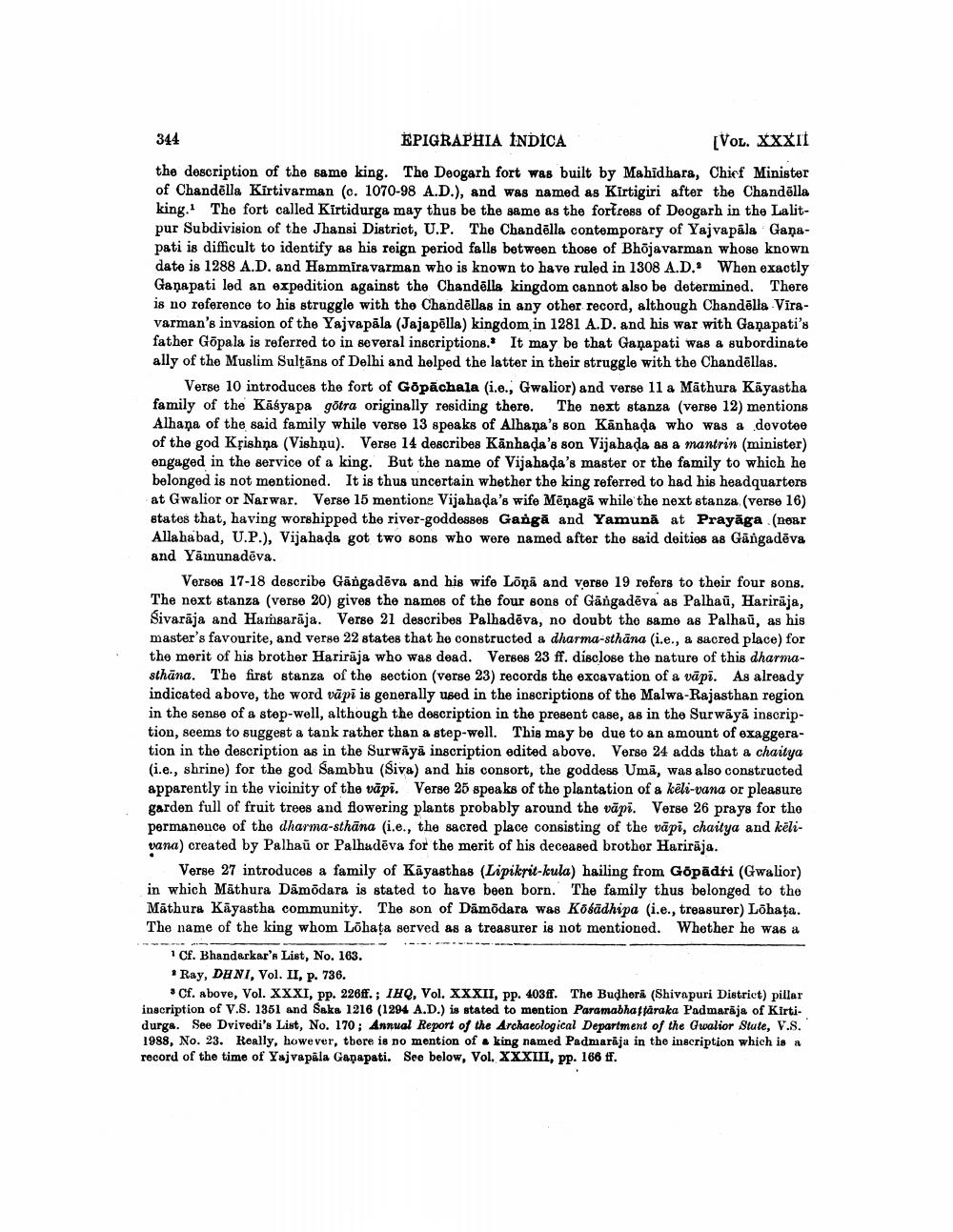________________
344 EPIGRAPHIA INDICA
[VOL. XXXII the description of the same king. The Deogarh fort was built by Mahīdhara, Chief Minister of Chandēlla Kirtivarman (c. 1070-98 A.D.), and was named as Kirtigiri after the Chandēlla king. The fort called Kirtidurga may thus be the same as the fortress of Deogarh in the Lalitpur Subdivision of the Jhansi District, U.P. The Chandēlla contemporary of Yajvapāla Gaņapati is difficult to identify as his reign period falls between those of Bhöjavarman whose known date is 1288 A.D. and Hammiravarman who is known to have ruled in 1308 A.D. When exactly Ganapati led an expedition against the Chandēlla kingdom cannot also be determined. There is no reference to his struggle with the Chandēllas in any other record, although Chandēlla Viravarman's invasion of the Yajvapāla (Jajapēlla) kingdom in 1281 A.D. and his war with Gaņa pati's father Gopala is referred to in several inscriptions. It may be that Ganapati was a subordinate ally of the Muslim Sulțāns of Delhi and helped the latter in their struggle with the Chandellas.
Verse 10 introduces the fort of Gopāchala (i.e., Gwalior) and verse 11 a Māthura Kayastha family of the Kāšyapa götra originally residing there. The next stanza (verse 12) mentions Alhaņa of the said family while verse 13 speaks of Alhaņa's son Känhada who was a dovotee of the god Krishna (Vishnu). Verse 14 describes Kānhada's son Vijahada as a mantrin (minister) engaged in the service of a king. But the name of Vijahada's master or the family to which he belonged is not mentioned. It is thus uncertain whether the king referred to had his headquarters at Gwalior or Narwar. Verse 15 mentione Vijahada's wife Mēnagā while the next stanza (verse 16) states that, having worshipped the river-goddesses Ganga and Yamunā at Prayāga (near Allahabad, U.P.), Vijahada got two sons who were named after the said deities as Gangadēva and Yamunadēva.
Versek 17-18 describe Gängadēva and his wife Lönä and verse 19 refers to their four sons. The next stanza (verse 20) gives the names of the four sons of Gängadēva as Palhaū, Harirāja, Sivarāja and Hamsarāja. Verse 21 describes Palhadēva, no doubt the same as Palhaū, as his master's favourite, and verse 22 states that he constructed a dharma-sthāna (i.e., & sacred place) for the merit of his brother Harirāja who was dead. Verses 23 ff. disclose the nature of this dharmasthāna. The first stanza of the section (verse 23) records the excavation of a vāpi. As already indicated above, the word vāpi is generally used in the inscriptions of the Malwa-Rajasthan region in the sense of a step-well, although the description in the present case, as in the Surwāyā inscription, seems to suggest a tank rather than a step-well. This may be due to an amount of exaggeration in the description as in the Surwāyā inscription edited above. Verse 24 adds that a chaitya (i.e., shrine) for the god Sambhu (Siva) and his consort, the goddess Umā, was also constructed apparently in the vicinity of the vāpī. Verse 25 speaks of the plantation of a kēli-vana or pleasure garden full of fruit trees and flowering plants probably around the vāpi. Verse 26 prays for the permanence of the dharma-sthāna (i.e., the sacred place consisting of the vāpi, chaitya and kēlivana) created by Palhaū or Palhadēva for the merit of his deceased brother Harirāja.
Verse 27 introduces a family of Kāyasthas (Lipiksit-kula) hailing from Göpādri (Gwalior) in which Mathura Damodara is stated to have been born. The family thus belonged to the Māthura Kāyastha community. The son of Damodara was Kötādhipa (i.e., treasurer) Lõhata. The name of the king whom Löhata served as a treasurer is not mentioned. Whether he was a
1 Cf. Bhandarkar's List, No. 163. * Ray, DHNI, Vol. II, p. 736.
* Cf. above, Vol. XXXI, pp. 226ff.; IHQ, Vol. XXXII, pp. 403ff. The Budhera (Shivapuri District) pillar inscription of V.S. 1351 and Saka 1216 (1294 A.D.) is stated to mention Paramabhaffäraka Padmarāja of Kirtidurga. See Dvivedi's List, No. 170; Annual Report of the Archaeological Department of the Gwalior Stute, V.S. 1988, No. 23. Really, however, there is no mention of a king named Padmarāja in the inscription which is a record of the time of Yajvapāla Ganapati. See below, Vol. XXXIII, pp. 166 ff.




